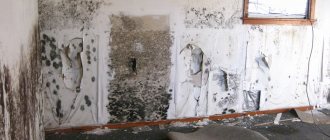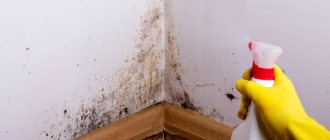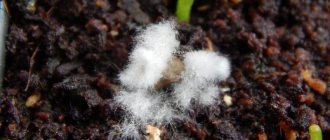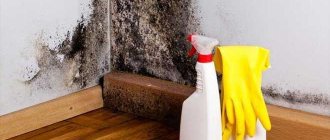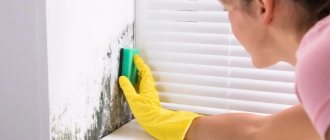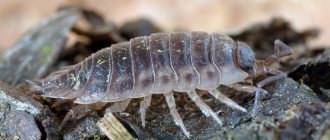- April 1, 2019
- Walls
- Ksenia Yedikhanova
Most people have at least once encountered the problem of black mold on the walls of their home. It consists of small black specks that no one pays attention to and simply erases them. Unfortunately, it soon begins to grow and become larger in size. How to get rid of black mold on the walls of an apartment? Effective methods and nuances are described in the article.
Habitat
Where is black mold most likely to appear? She, like all fungi, needs a nutrient medium. The most suitable conditions for its life are damp places. For example, if there is a problem with leaking pipes in the bathroom, then there is a high probability of dark spots forming on the walls.
In addition, black mold can be found anywhere - in the refrigerator, near ventilation grilles, vents, on bread, fabric, under the sink, bathtub, at the joints of tiles, in places where the shower stall or bathtub touches the walls.
The main condition for the existence of black mold is high humidity. It can feed on both organic and inorganic products, such as glue and wallpaper.
Possible complications
The consequence of damage to the central nervous system is thrombosis of the cavernous sinus, located in the brain, and the internal carotid artery. Blockage of the latter by a thrombus leads to cerebral infarction. Fungal damage to the optic nerve can lead to blindness.
Carotid artery thrombosis is a life-threatening condition that can result in sudden death. Timely diagnosis and treatment are crucial: the photo schematically shows the pathological process
Pulmonary mucormycosis is dangerous due to the development of acute respiratory failure and excessive bleeding. In addition, dying lung tissue in conditions of lack of oxygen is an excellent breeding ground for various microbes, the activity of which can cause secondary pneumonia.
The gastrointestinal form of Black mold can be complicated by perforation of the intestinal wall and lead to bleeding, as well as inflammation of the peritoneum - peritonitis.
Causes
How to get rid of black mold in an apartment? To do this, you need to eliminate the main causes of its occurrence. As stated earlier, the optimal habitat for mold is high humidity in the home, which, in turn, is provoked by the following reasons:
- poor ventilation;
- dampness in the basement;
- walls that freeze in winter;
- a large number of plants that require frequent spraying;
- constant drying of large amounts of laundry in the living room;
- poor insulation of inter-wall seams and cracks;
- insufficient heating of the home.
Mold can also appear if there are cracks in the house through which moisture enters from the outside and destroys the wall from the inside. If mold gets inside such a crack, getting rid of it can be problematic.
The dangers of mold and mildew
Firstly, such a neighborhood has an adverse effect on the health of residents, becoming a catalyst for diseases such as:
- asthma,
- pneumonia,
- sinusitis,
- skin rashes,
- migraine,
- stomach upsets,
- nosebleeds,
- various respiratory tract lesions.
But, secondly, it destroys the house, and does it from the inside. External manifestations of mold are just the tip of the iceberg, as they say, and even after getting rid of the stains, you can expect them to return after a while. Which suggests that first of all it is worth fighting not the effect, but the cause, that is, eliminating the favorable conditions created for the development of the fungus.
Types of mold
In order to know how to remove black mold, you need to decide on its type. The general name usually refers to several of the most common types of molds:
- Aspergillus black is a fungus that loves high humidity. This is what appears in the bathroom, kitchen or even in the air conditioner. Most often it attacks the seams between tiles in the bathroom or toilet.
- Aspergillus fuming, the peculiarity of which is that it can easily withstand temperatures up to 53 degrees, and is therefore resistant to high temperatures in the bathroom.
- Alternaria alternata is a black fungus that attacks fabric and food, as well as wood.
These mold spores are equally dangerous to both humans and pets, so if they appear, you should get rid of them as soon as possible.
Why does black mold appear in the house?
The fungus likes it to be humid and warm. Temperatures from +18 to +25 degrees and humidity from 60-70% are a sure way to win his trust.
In addition to these two factors, there are other, less obvious ones. For example, a “mushroom” colony may come for a visit some time after a fresh renovation. What then is the reason?
Ventilation
More precisely, its absence, especially in the bathroom and toilet. The presence of a window in such places is not expected, so “getting out” the humid air from there is a real problem. And, as you know, a lot of it accumulates there: from drying clothes, during water procedures, etc. It is difficult for natural exhaust ducts to cope with such pressure, so removing black mold will only be possible if you have to forcefully ventilate the room.
Gypsum boards
With the help of this building material, any, both horizontal and vertical surfaces are leveled, and partitions of varying complexity are erected.
The only drawback of plasterboard boards is the ability to absorb moisture and retain it inside. In order to prevent this flaw from appearing, you need to carefully work with the material: follow the installation technology, let the mixtures dry, etc.
Plastic windows
PVC windows certainly have a number of advantages: amazing sound insulation, heat retention, ease of use, etc. But don’t let the listed advantages cloud your mind - plastic windows have disadvantages!
One of them is tightness. This can be the cause of black mold. Wooden windows easily evaporate moisture and allow air to pass through, in a word - “breathe”. This does not work with plastic windows - hence the problems.
In addition, not everyone who installs windows can install them correctly - this is another “bonus” in the piggy bank called “reasons for the spread of black fungus.”
However, regular ventilation can change the situation for the better.
Basements and walls
Everything is clear with basements (the presence of drainpipes suggests excess moisture), but what could be wrong with the walls? Miscalculations in the design of a house lead to the fact that during rain the walls, especially their corner parts, get wet, and in cold weather they freeze. Over time, black mold can eat through even tough brickwork, especially if it has cracks. Read also: Mold in the basement. The first bell is that the house is collapsing
What is the danger?
At first glance, mold may seem unpleasant but harmless, but this is not the case. Black mold can cause serious harm to humans, including death. If you live near mold fungi for a long time, the following health problems may appear:
- Dermatitis and other skin diseases, the nature of which is difficult to determine, which means they are difficult to treat.
- Diseases of the respiratory system, such as asthma, bronchitis, pneumonia.
- Diseases of the musculoskeletal system, as mold spores negatively affect human joints.
- Allergic reactions up to Quincke's edema.
- Once inside the body, black mold can cause disorders in the functioning of internal organs, especially the stomach and intestines.
When living for a long time in a home with mold, a person becomes irritable, prone to depression, weakness in the body, and frequent headaches. With a high concentration of spores of the fungus of the genus Aspergillus, intoxication of the body can occur.
Elderly people and young children are most vulnerable to mold because their immune systems are not strong enough to fight mold spores on their own.
How to avoid getting mucormycosis?
1. You should not eat hormones when they are not prescribed to you. If you have been prescribed them, then both you and the doctors need to stop in time. 2. If there are factors that can lead to mucormycosis, then they must be eliminated: control sugar, do not take iron supplements. If you have an immunodeficiency and a combination of the above factors, you need to be careful. 3. Diabetics and people recovering from coronavirus (while taking hormones) should not do garden work or dig for worms. Contact with soil, especially with compost pits, is dangerous. 4. The respiratory tract should be protected. If it is not possible to avoid contact with these spores, wear a respirator. 5. Avoid skin contact with soil.
shutterstock.com
First signs
Before you remove black mold from walls or other surfaces, you need to find it. Most often, the first spots of mold can be found in the following places:
- on tiles and joints;
- in places where the bathtub comes into contact with the walls;
- in the corners of the room.
First, small spots of a brown or greenish tint appear, which then grow into large colonies of mold fungi. Also, a specific musty smell appears in the room, by which you can unmistakably determine the presence of mold in the house.
How to get rid of mold?
Thorough mold removal can provide long-term symptom relief
For long-term relief of allergy symptoms or black mold poisoning, it is important to avoid or reduce exposure to it. This may require thoroughly removing mold from all surfaces in a person's home or workplace and taking steps to prevent its return.
There are many commercial cleaning products that can kill mold and prevent it from coming back. Alternatively, people can make a cleaning solution at home by adding 1 cup of household bleach to 4 liters of water. When working with bleach or harsh cleaning products, it is essential to wear protective gloves and goggles.
People will need to completely clean the entire room or affected area and make sure they have eliminated all signs of mold. They should also dry surfaces to prevent future regrowth.
It is recommended that all filters, vents and ducts be cleaned whenever possible to prevent mold growth in air conditioning systems and humidifiers.
Porous items with mold contamination, such as mattresses, carpets or drywall, can be difficult to clean. You may need to replace them where possible or hire a professional cleaner.
When cleaning up mold, it is important to ventilate the area as much as possible by opening doors and windows or turning on fans.
Mold Prevention
People can prevent or minimize the possibility of future mold growth by following these guidelines:
- Regularly clean any areas where mold is likely to grow (bathrooms, showers and wet rooms).
- Use a dehumidifier to reduce the amount of moisture in the air, especially in areas where humidity is a problem. Mold prefers to grow in damp and wet places.
- Keep all walls and surfaces dry.
- In cold or damp weather, rooms should be warm and well ventilated.
- Install and use exhaust fans in wet areas such as bathrooms and kitchens, and do not place carpets or rugs in them.
- Check pipes, gutters and air conditioners regularly to avoid possible leaks and water seepage.
Folk remedies
How to eliminate mold on the walls in an apartment? In the event that the fungi have not yet managed to form a large colony and look like individual small spots, folk remedies that have been proven over the years can cope with them:
- Medical ethyl alcohol 96%. Directions for use: Apply a small amount of alcohol to a sponge and wipe the fungus-affected areas. To enhance the positive effect, it can be mixed with ammonia and glycerin; this composition is applied to the affected areas for half an hour and then washed off with water. This method works well for tiled or plastic surfaces.
- Baking soda. Directions for use: a few tablespoons of ordinary baking soda should be dissolved in water, and the resulting solution should be sprayed onto the fungal affected areas. After this, use the hard side of a sponge with a small amount of citric acid to thoroughly rub the areas where fungi have formed.
- On horizontal planes, it is convenient to use the following method: pour a small amount of soda onto the contaminated surface, and then pour 9% table vinegar on top. The reaction that occurs between them will help get rid of mold quickly.
- Copper sulfate. How to get rid of mold in the house on the walls with its help? To do this, you need to dilute 10 g of the substance in 1 liter of water and apply it to the affected surface using a spray bottle.
- For mild damage, you can use tea tree essential oil. It must be mixed with salt, a small amount of water, and then applied in a thin layer to the area affected by the fungus.
Numerous reviews also report that mold can also be removed using hydrogen peroxide, which needs to be sprayed on a colony of harmful fungi.
Inhaled and already became infected?
But if the fungus often occurs on product No. 1 - bread - then why is there not mass infection in Russia? The fact is that in the absence of open wounds and unsanitary conditions, it is almost impossible to “mold”, since people’s immune defenses are triggered.
The exception is for persons with immunodeficiency conditions caused by:
- diabetes mellitus;
- malignant pathologies;
- chemotherapy treatment;
- organ transplantation;
- taking hormonal drugs;
- AIDS;
- coronavirus infection.
In the case of coronavirus, two risk factors are combined at once - the Sars-CoV-2 virus itself and the use of steroids, which are used to treat its severe forms.
The first information and photos of patients with mucormycosis in India began to arrive in May 2021
Thus, people living in the tropics and subtropics, below the poverty line, and with chronic diseases have the greatest chance of getting sick.
Important!
“Black” mold was named for the characteristic color of the scabs that form on dying tissue.
According to A. Baranova, a professor at the School of Systems Biology at Mason University, “to become infected, you almost need to climb into the mycelium itself. The chance of infection increases if a diabetic, for example, cleans a room of mold. Or a patient with HIV will spend quite a long time in a damp room where there is mold on the walls.”
If you need to be in public places - ride the subway during rush hour, visit crowded shopping centers, etc. - use Nazaval nasal spray. It protects the mucous membranes from pathogenic elements, including various viruses.
The drug acts as a natural barrier, creating a transparent film that prevents contact of the pathogen with the mucous membrane. The protective effect appears 10-15 minutes after spraying.
Nazaval spray is included by the Russian Ministry of Health in the list of recommended means for the prevention of Covid-19.
*There are contraindications, please consult a doctor
Chemicals
How to remove mold on the walls in an apartment? There are several methods available:
- You need to take any bleach that contains chlorine, pour it into a spray bottle and generously spray all affected areas.
- Ammonia and water should be diluted in equal quantities. The composition is applied to the mold colony, and then, after 2 hours, washed off.
- Using chlorine powder is also quite effective. It must be diluted with water according to the instructions, and then applied to the mold. This product is very toxic, so its use is only possible if a protective respirator and gloves are used.
How to get rid of mold on the wall? Reviews often recommend using the drug "Furacilin", which is known for its antiseptic properties. To do this, you need to crush 10 tablets into powder and dissolve in a glass of water. Use the resulting liquid to spray the areas where molds grow. After some time, you need to clean off any remaining fungi with a stiff brush and re-treat the surface with an antiseptic. This product is yellow in color and also leaves marks, so it is recommended to use it only on tiled or plastic surfaces.
The most inexpensive means for removing and preventing mold
Abedis 06
A Polish product with a high level of safety, Abedis 06, is universal and can be used in children's rooms. The main component of the product is guanidine, a strong antiseptic. The product is suitable for the interior and exterior of buildings, as well as small structures such as gazebos or greenhouses. This emulsion can also be used to disinfect garden paths. "Abedis 06" can be used for preventive purposes (the drug can be added to paints and solutions) and to remove fungal plaque.
Before work, the emulsion must be diluted with water in a ratio of 1: 2, and then treated contaminated surfaces with the resulting solution. The mixture is left for a day until completely dry, after which it is washed off with water. When the treated surface is completely dry, it is recommended to repeat the procedure, but not earlier than after 3 days. Despite the harmless composition, it is necessary to use protective equipment during work.
The average cost is 177 rubles.
Neomid Bio Repair
Ecological disinfectant made in Russia. Thanks to its formula containing substances harmless to humans, as well as a reasonable price-quality ratio, it has gained particular popularity. Available in the form of a ready-made solution for treating small rooms, apartments, or as a concentrate for cleaning large areas of contamination. In addition, Neomid Bio Repair is used during the construction phase as a preventive agent to prevent mold growth.
The drug is sprayed onto the infected area and then left for two hours. After this, they are removed with a scraper. If necessary, the procedure can be repeated. If the treatment is carried out outdoors, it is not recommended to obtain humidity on a clean surface: the humidity should not exceed 60% and the temperature should be between 15 and 20 degrees Celsius. If treatment is carried out indoors, ensure good ventilation. The duration of the effect, according to the manufacturer, reaches 20 years.
The average cost is 289 rubles.
Biotol spray
A powerful Russian antibacterial agent for treating surfaces made of natural stone, wood, concrete and other common materials. The product does not contain heavy metals, mercury and chlorine. Has a slight chemical smell. Biotol-Spray demonstrates a wide range of applications: treatment of basements, building facades, attics, roofs, balconies, as well as disinfection of architectural monuments, memorial fences, slabs and restoration work.
If the infection is severe, the surface must first be mechanically cleaned of mold with a scraper or brush, carefully removing the layer of contamination, trying not to spread the fungus to adjacent clean areas.
It is recommended to spray the spray onto the treated area from a distance of 30 cm, then leave the solution for a day or two, after which you can remove the drug along with the fungus and clean the surface with a brush. The solution can be reapplied if the infection is old or advanced.
The average price is 300 rubles.
Belinka
A widely used drug produced in Slovenia. "Belinka" does not contain bleaching agents and does not change the color of the treated surface, therefore it is used for treating painted surfaces. The substance quickly and successfully removes numerous types of fungi both in dry rooms and in places with high humidity. Designed for treating concrete and plastered surfaces, used for decontamination of ceilings, walls, floors, attics and basements.
First you need to prepare a solution in a ratio of 1: 4, which is applied to the affected surface with a brush or spray. It is recommended to work at temperatures above 5 degrees Celsius and humidity levels not exceeding 80%. After the solution has completely dried, contaminants can be removed, preferably with hot water and under pressure. It is best to clean large areas affected by fungus. After drying, you need to apply a primer and then a finish.
Average cost 350 rub.
Professional products
How to get rid of black mold on walls yourself? If folk remedies for fungi do not bring the expected positive effect, then you should pay attention to professional remedies. They will cost a little more than using simple soda or vinegar, but manufacturers promise 100% results. Among the most popular means are the following:
- Anlas Mykos is a powerful and effective remedy that can help get rid of even outdated and overgrown mold colonies.
- Profilux is a drug that has an effective effect on mold that has affected wooden surfaces.
- “Antisept” is a Russian-made product that is widely used for antiseptic preventive treatment of surfaces at the repair stage.
- Schimmel Vernichter helps eliminate mold on all types of surfaces. It is highly effective against most known varieties of fungi.
Since professional mold removal products are highly concentrated, it is recommended to use protective equipment such as a respirator and rubber gloves.
What you need to pay attention to when building a frame house
When arriving at a construction site, pay attention to how the timber is stored. It must be either in a special room or stored outside, in compliance with all requirements:
- stored on pallets so that the material does not touch the ground;
- there should be a gap of several millimeters between the boards;
- the timber must be covered with a protective film.
By following these simple rules, you can get rid of a large number of problems in the future. Our lumber is additionally treated with antiseptics during production, which allows you to avoid problems in the subsequent operation of your home.
Help from specialists
How to get rid of fungus on the wall in an apartment if all proven methods do not bring the desired effect? This is possible if walls infected with harmful fungus have porous surfaces or cracks. How to understand that you need help from competent specialists? The following factors may indicate this:
- The total area of the affected space exceeds 3 square meters. With such an extensive mold infestation, it is quite difficult to deal with them on your own.
- If mold has entered the ventilation system or air conditioner.
- Even with regular cleaning of small lesions, they grow at a fairly high rate.
- Molds appear as a result of extensive water or sewage flooding.
Experienced specialists have tools that allow sanitization even in the most difficult to reach places. These technologies can influence not only the external manifestations of the fungus, but also directly the mycelium.
Tests That Can Indicate Mold Affects Health
If you have found symptoms and want to get some more confirmation that mold is involved in your illness, you can consider the following tests:
Visual Contrast Sensitivity Test
The VCS test , associated with biotoxin disease, is reported to be fairly reliable (though not 100%).
This is a vision test that can be administered via computer to assess a person's ability to see clearly even in situations with low visual contrast (a skill that tends to be impaired in people with CIRS).
Dr. Richie Shoemaker offers an online VCS screening test
(widely tested on its patient population) for a small fee on its website, Surviving Mold.
A similar test can be taken for free on another site.
(Knowledge of English required)
Laboratory diagnostics
These tests will likely be available to you if you are in the US or Europe.
But there is no consensus in the biotoxin disease community about the usefulness of these tests.
Urine analysis for mycotoxins
In particular, regarding the American RealTime Labs tests, there is information about their low sensitivity and frequent false-positive and false-negative results.
In studies, the sensitivity of the ochratoxin test was only 17%.
The sensitivity of the aflatoxin test was 70.6%
The macrocyclic trichothecene test has a sensitivity of 94.5%, which is quite high. But many people with documented severe Stachybotrys problems have not tested positive for this toxin either in the home or after moving.
Also, these tests have not been subjected to all the necessary testing in blind, placebo-controlled studies, and have not been approved by the FDA and CDC.
ELISIA tests may be more reliable. But due to the fact that they are difficult to obtain while in Russia, I did not thoroughly study the issue of their reliability. If you want to rely on such tests to make decisions, I recommend doing your own research.
Urine analysis for organic acids
(Available in Russia)
Oxalic, citric, fumaric, glycolic (without increased oxalic) and any fruit acids in large quantities in an organic acid test may indicate the growth of Aspergillus in the body. To decipher this analysis, you need the help of a specialist who is well versed in it.
Allergy testing
Doctors sometimes suggest that patients who suspect they have mold problems take an allergy panel for common molds. These tests look for the body's response to mold, which may (or may not) produce toxins, rather than the body's response to the toxins themselves.
While people with toxic mold are indeed more likely to have IgE mold allergies than the average person, there are many people with CIRS who do not have such allergies. Additionally, there are many people with elevated mold IgE levels who do not have toxic mold disease.
Therefore, when considering these tests for yourself, keep in mind that:
- They do not show the presence of toxins in the body and the reaction to them.
- In Russia there are no tests for all possible types of mold.
- If you already have severe immunodeficiency, then antibodies may not be developed in this case.
HMS according to Osipov
I have not seen anywhere recommendations for using this test to detect the presence of fungi in the body. In my case, the presence of Aspergillus spp. in the large intestine in a large titer was a completely random finding.
That is, you will not check for the presence of toxins with this test, but if you already have aspergillosis, then I think this test can be considered.
MRI scan with NeuroQuant® analysis
(Available in the US and Europe only)
NeuroQuant is a cutting-edge, innovative brain imaging solution that quantitatively analyzes MRI brain images and enables the analysis of structural changes in the brain associated with exposure to biotoxins.
The software uses information from thousands of brain scans to find these areas of damage with greater precision than what can often be found through analysis by a radiologist.
Specifically, NeuroQuant will show that some parts of the brain are enlarged while others are atrophied due to the inflammatory response.
Damage to certain structures in the brain may be associated with certain biotoxins. For example, biotoxins from mold have been found to affect various brain structures differently than biotoxins from Lyme disease.
How to remove odor
How to get rid of mold on the walls in an apartment? Using the folk and chemical remedies described above, you can effectively remove the source of mold damage. Despite this, the characteristic odor may remain. In order to get rid of it, you can try the following methods:
- It is important to thoroughly dry the area from which the mold was removed. This can be done using a hair dryer. This point especially applies to wooden surfaces, which absorb moisture and odors.
- Baking soda is known for its ability to absorb odors well, so you can sprinkle it on the areas where the fungus is spreading and rub it well with the rough side of a sponge.
- You can try mixing boric acid, which is known for its antiseptic properties, hydrogen peroxide, table vinegar and water in a ratio of 1:1:1:2. Treat the surface with the resulting mixture and leave for 2 hours, then rinse with plenty of water.
How to get rid of mold on the walls in an apartment and its smell? Prolonged ventilation and drying of the room also helps to remove the obsessive moldy smell.
Types of mold
Mold stains that often appear in the home come in several varieties.:
- Whitevine - most often found in flower pots due to overwatering or using too much fertilizer
- Green vine - often found on building materials
- Black mold - this fungus appears in apartments and houses more often than others. It has subspecies. A common feature they all have is color, which appears at a certain stage of development. It also matters on what surface the mold settles.
- Blue mantle - often forms on wooden surfaces, gives them a milky blue tint and dissolves the varnish layer;
- Rotting mold is also the most common contaminant of wood, causing it to disintegrate and turn gray or brown.
The possibility of detection depends on how far the mold has spread in the indoor air and settled on surfaces, acting from the very beginning in the air. Most often these are cough, nausea, shortness of breath and chronic diseases that are difficult to diagnose. It can also cause nausea, headaches and fatigue.
These are all the result of being in a damp room full of mold. Therefore, it is important to fight it in a timely manner, as soon as its manifestations appear. There are many options to fix it.
Other methods
How to get rid of black mold on walls? Reviews note that the following methods are also effective:
- A weak solution of potassium permanganate has excellent antiseptic properties. Unfortunately, potassium permanganate is difficult to find today, but many people still have old supplies.
- Grapefruit seed extract. You only need 10 drops per 1 glass of water. The resulting solution should be sprayed onto the affected areas. The extract not only destroys mold fungi, but also has a pleasant aroma.
- Lavender or rosemary oil has antiseptic properties. The method of application is similar to using grapefruit seed extract.
- Citric acid allows you to get rid of not only scale in the kettle, but also a small colony of mold fungi. To do this, you need to dilute the sachet with the substance in 1 glass of water, and then apply it to the affected areas using a sponge.
How to get rid of black mold on walls? In the fight against fungal infections, all means are good, since they are extremely dangerous to the life and health of the inhabitants of the home.
Genetic Testing: Human Leukocyte Antigen (HLA DR) Test
To determine whether a person is genetically susceptible, HLA DR/DQ genetic testing is used. The human leukocyte antigen (HLA) system is a set of genes on chromosome 6 that encode proteins on the surface of cells that are responsible for regulating the immune system in humans. These proteins help our immune system distinguish our own cells from foreign ones. The HLA type and its associated immune response are key factors in whether a person develops the inflammation that leads to CIRS.
Explanation: The immune system consists of the innate immune system (the immunity we are born with) and the adaptive immune system (the immunity we develop after birth). The innate immune system is nonspecific and acts as the first line of defense by identifying antigens (foreign proteins) to signal the adaptive immune system, releasing high levels of inflammatory molecules (such as cytokines), broken complement products, and beta TGF. -1. Unlike antibodies, inflammatory molecules do not have a specific target and cannot remove biotoxins. The adaptive immune system provides long-lasting immunity by creating immunological memory after initial exposure to a specific pathogen (such as a biotoxin).
In susceptible individuals, the innate immune system “sees” the biotoxins and continues to signal to the adaptive immune system. However, the adaptive immune system cannot “see” biotoxins and does not produce adequate antibodies against them. The constant transfer of biotoxins continues to challenge the innate immune system. In turn, an overactive innate immune system creates high levels of inflammation, leading to dysregulation of multiple systems in the body and the development of CIRS.
Dr. Shoemaker's review of international gene registries, coupled with case-based studies, found that 24% of the population is exposed to mold due to their HLA haplotype, putting them at risk of developing biotoxin-related chronic disease from exposure water damaged buildings. Depending on individual HLA gene combinations, a person may be susceptible to one or more biotoxin-related diseases. For example, one person may be “mold susceptible,” while another may be “Lyme susceptible,” and another may be “multiple susceptible.”
Prevention
In order not to have to think about how to get rid of black mold on the walls, it is important to pay attention to the following preventive points:
- Eliminate leaks from pipes in a timely manner.
- Set up an apartment ventilation system.
- Regulate the number of indoor flowers, since their excess quantity provokes the appearance of high humidity in the apartment.
- Insulate the walls of the house and repair cracks, if any.
- Use a hood when preparing food, as this evaporates a fairly large amount of moisture.
- Do not overuse household humidifiers.
- Use the balcony to dry clothes.
It is also recommended to monitor the serviceability of the heating system, the integrity of the roof in the house and promptly get rid of the slightest manifestations of the fungus before its colony grows too large.
Genetic predisposition to CIRS
Figure 1. Actions of biotoxins in the body of a genetically non-susceptible person.
Figure 1 (above) shows how biotoxins affect a person who is not genetically susceptible to developing biotoxin disease. In this situation, the immune system correctly recognizes the biotoxin, which leads to the production of antibodies and their removal from the body.
Figure 2. How biotoxins affect a person with a genetic predisposition
Figure 2 shows how biotoxins affect a person with a genetic predisposition. The immune system cannot correctly identify the biotoxin, bind it and remove it. This allows the biotoxin to recirculate through multiple body systems, causing damage along the way. In this case, the biotoxin can remain in the body indefinitely.
It is because of immune system dysfunction and exhaustion due to long-term systemic inflammation that exposure to mold can be very dangerous for a genetically susceptible individual.
Against the background of a severely weakened immune system, an inflammatory and infectious process may begin with the participation of conditional pathogens that are normally present in the body and controlled by the immune system. So I suffered a neuroinfection and was disabled for a long time. According to doctors, this is done by herpes viruses, which, again, represent a normal part of our microbiome.
While I was researching the topic of mold toxicity, I came across news stories like this several times.
“On December 9, 2009, actress Brittany Murphy died from a lung infection that turned out to be Staphyloccoccus aureus, a very common bacterium that a healthy system should be able to control.
Five months later, the late actress' husband Simon Monjack died while still living in the same house. Relatives and experts later concluded that the home and toxic mold were likely involved in the deaths.
